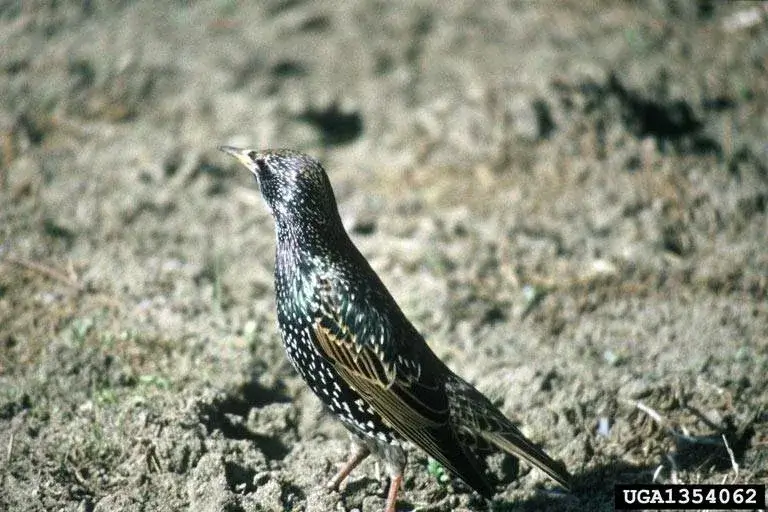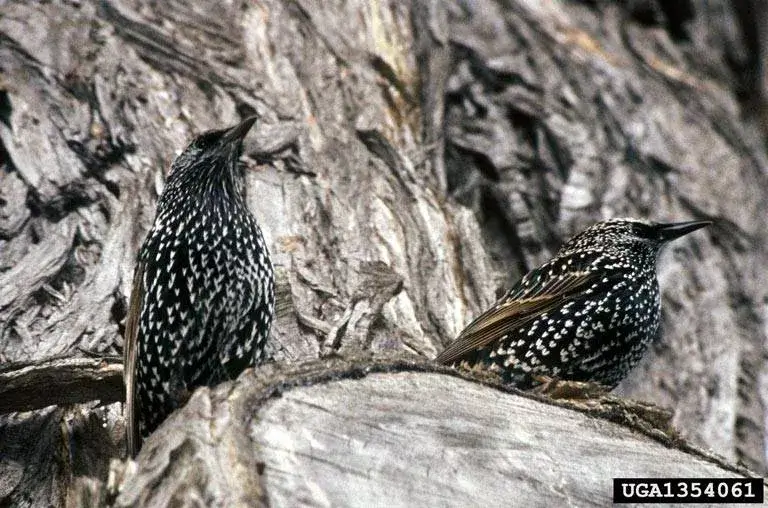
The European starling (Sturnus vulgaris) is native to Europe and then was introduced into other countries around the world including North America. European starlings have a glossy black appearance and are commonly found in large flocks whose flying is synchronized. About 100 starlings were first introduced by Shakespeare enthusiasts in 1890 in Central Park, New York and are now one of the most abundant birds in North America with a population of approximately 200 million. They are found across the entire United States and compete with native species as well as destroy crops.

European starlings are well adapted to living in a variety of environments. Starlings are ground foragers that feed on a variety of insects in the soil as well as various seeds and fruits available. They tend to prefer open grasslands or habitats with low tree and shrub cover. During the breeding season, starlings will nest in cavities, such as holes in trees or other protected spaces. Starlings are very well adapted to disturbance and can be found in rural and urban environments.

European starlings were intentionally introduced into the United States in Central Park, New York because those admiring the works of Shakespeare wanted to see all the birds mentioned in his creations represented in North America. One of the contributors to the success of this invasive species is the starlings’ flexibility in habitat selection (Clergeau and Quenot 2006). Starlings are prolific breeders producing on average one to two clutches per year with four to six eggs per clutch for each nesting pair. Eggs are incubated for approximately 12 days before hatching and then it takes about 3 weeks for nestlings to fledge (Linz et al. 2007). Starlings can live for approximately 2-3 years or more.

The damage caused by European starlings on the agricultural industry was estimated to be approximately $800 million per year at $5 per hectare (Pimentel et al. 2000). Starlings eat cattle rations and destroy fruit and grain crops. Some starlings may also carry various diseases which may be transmissible to humans, other birds (including poultry), and livestock (Linz et al. 2007).
Due to the flocking nature of starlings and being well adapted in urban settings, roosts near airports have become a large problem. If a plane flies through a large flock of starlings, the birds can get caught in the jet engines causing damage to the aircraft as well as pose a hazard to humans. Additionally, in urban and rural settings, bird may seek shelter in barns and industrial buildings and create a lot of noise and filth which pose health hazards.
Ecologically, starlings may outcompete native cavity-nesting birds for nest sites. While there are no significant results indicating species declines for all native cavity nesters due to starlings, Koenig (2003) did find that certain species, such as native sapsuckers (Sphyrapicus spp.) were negatively impacted by starling presence. Starlings are also frugivores, meaning they feed on the fruits of plants. When fruits pass through the system of a bird after being ingested it may increase the likelihood that those seeds will germinate in some cases. A study done in 2009 found that the digestive system of starlings will increase seed germination after feeding on invasive autumn olive (Elaeagnus umbellata) and invasive oriental bittersweet (Celastrus orbiculatus) fruit and that the seed stayed inside the starlings long enough for dispersal to occur (LaFleur et al. 2009).

Starlings look similar to blackbirds and have a short, square tail with a slender, yellow beak. Their wings are pointed and triangular. The plumage of a European starling is a glossy black with green, purple, blue or bronze iridescence. In the fall, starlings may have a spotty appearance after molting, but the spots on their wing tips wear away by spring. Male and females look similar however, the female may have a slightly duller appearance. Additionally, in the breeding season the lower mandible of the beak in males will appear blue-gray and pinkish in females. Starlings are noisy birds making many clicks, whistles, rattles, squeaks, and sounds mimicking those from their environment or songs from other birds.


To prevent further spread of European starlings, eggs and nests can be destroyed before the nestlings are able to fledge. Sticky polybutene materials may also be placed in roosting sites to deter birds from landing in a specific area. The most common for removing already established flocks of starlings from an area, is to frighten or harass the birds using propane exploders, pyrotechnics, hawk kites, and ultrasonic sounds. However, using these harassing techniques for control produces only temporary results, as the birds may come back once the control methods are stopped or once they are no longer frightened by them. There are chemicals that have been used that stimulate erratic behavior in birds that ingest it, which frightens other birds away and eventually kills the consumer. Other toxic chemicals, or Starlicides can be used which poison the birds and are lethal within 1-3 days, however non-target birds, such as native song birds, hawks and owls may also be affected if they consume the toxicants. Typically, these chemicals are quickly metabolized and are excreted which reduces effects on organisms higher in the food chain that consume the birds (Linz et al. 2003). When using any chemical, remember to read and follow the directions on the label.

European starlings are native to Europe and in parts of Asia and Africa. They were introduced into North America, South Africa, New Zealand, and Australia. Starlings are now found across the United States, in the Bahamas, Central America, Yucatan Peninsula, Puerto Rico, Jamaica, and Cuba.
Lynch, Jennifer A. and Terry A. Messmer. European Starlings. 2010. Wildlife Damage Management Series. Utah State University Cooperative Extension. Fact Sheet. 4 Pages. http://extension.usu.edu/files/publications/publication/NR_WD_011.pdf
